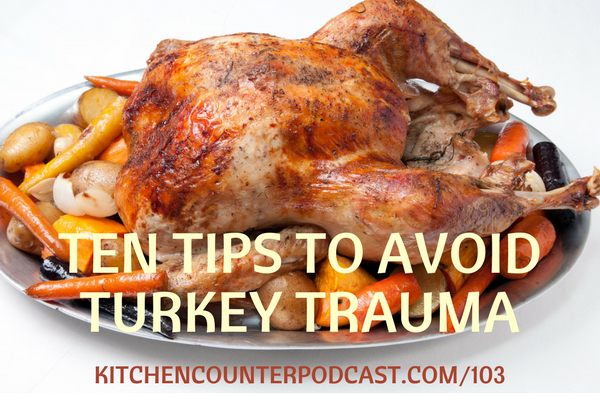
Nothing seems to strike fear in the hearts of home cooks all over the United States like the prospect of making Thanksgiving dinner for family and guests. Mix one part act of cooking so much food and trying to make it come together perfectly, one part family dynamics (especially if politics come up in table conversation), and one part endless information online of how to make “the perfect turkey,” and you have a recipe for a high stress holiday.
I’m here to help with ten tips to make your turkey prep a lot less crazy. Here’s the deal: there are a thousand methods to cook a turkey, and each year a new fad technique sweeps the land and everyone thinks to make a tasty bird you need to brine, or smoke, or deep fry, or roast upside down, or…well you get the idea. The truth is that you don’t need to do anything overly complicated to make a delicious turkey. It’s not quite as simple as making a box of mac and cheese, but with these tips you are on your way to a simple, tasty turkey that won’t test your patience or your skills.
Ten Tips to Avoid Turkey Trauma
Get an instant read thermometer, preferably one with remote monitoring cable that comes out of oven and connects to monitor on countertop
If you only take one tip to heart, take this one. The main culprit for dry, chewy turkey? Overcooking. Use a digital meat thermometer to ensure you nail the temp before the bird dries up. NEVER rely on the crappy little plastic “pop-up” timer plug that comes stuck in most grocery store turkeys; they are extremely inaccurate and unreliable. It’s even better if you can get a thermometer with a remote probe so you don’t have to open the oven and pull the turkey out to check the temp. When the thickest part of the thigh hits 165F you are good to go.
Here’s a reasonable thermometer with remote probe:
Use a proper roasting rack
A roasting pan with rack will do a couple of things for you. First it will keep the turkey raised off the pan so air can circulate below and cook more evenly. Second, your turkey won’t be sitting in it’s own drippings and getting greasy and oily. Plus, a good pan will catch all those tasty drippings which will be the base for a dynamite gravy.
Here are a few inexpensive racks that will do the trick:
Pick the right turkey size
Which is worse? Not having enough turkey to feed your guests, or not having any leftover turkey to nibble on for days after the big feast? Trick question. Both scenarios suck. You can use this super handy turkey calculator from Butterball to figure out turkey size with or without leftovers, or just figure about 1 pound per adult and 1/2 pound for child who will be eating the turkey that day.
If you have a frozen turkey, remember to thaw well in advance!
Frozen turkeys take a long time to thaw; usually several days in the fridge. A 16 pound bird takes about three and a half days to thaw; larger birds take longer. Use this cool thaw time estimator from Norbest to calculate how long yours will take. Forget to thaw the turkey? Norbest to the rescue again!
Stuff the cavity of the bird with aromatics
It’s safer to cook your traditional stuffing outside of the bird (and it will allow your turkey to cook more quickly). That doesn’t mean you have to leave the cavity completely empty. I like to stick a couple of onion wedges, garlic cloves, and a cut up lemon in my turkey’s cavity. The aromatics will add depth to your turkey and drippings. Other good stuffing items include celery, carrots, apples, and fresh herbs like thyme or rosemary.
Don’t go crazy preparing the outside of the turkey
There is much out there about how to prepare the outside of the bird before roasting. The truth is you don’t need to do anything fancy. Brush olive oil all over the turkey and apply a liberal amount of salt and pepper. The oil will help crisp up the skin and the simple seasonings let the turkey shine.
Cover the turkey with foil for the first 2/3 of the time to prevent over-browning of the skin
You can remove the foil for the final 1/3 or so of cooking time to let the skin brown up and get crisp.
Give yourself plenty of time to roast
Part of the dance of preparing a holiday dinner is making all of the various dishes come out at the same time. The turkey is your pacing item; it will take far longer than anything else to cook. Even though you have your digital thermometer you still want to know in advance approximately when your turkey will be done so you can plan everything else. A good rule of thumb is 18 minutes per pound at 325F degrees.
When the turkey is done let it rest for at least 20 minutes
Loosely tent aluminum foil over the turkey after you remove it from the oven and let it rest for about 20 minutes. This will give you time to heat up your sides. If you need longer your turkey will stay nicely warmed for up to an hour if you cover with foil and drape with a dish towel.
Carve the turkey properly
If you carve your turkey by slicing right off the breast and serving (which is how you always see it in pictures) please stop! Slicing turkey this way actually results in a tougher, chewier serving because you are slicing with the grain. It’s far better to break the turkey down first. Remove the drumsticks, thighs, and breasts whole and then you can slice pieces up against the grain. That means more juicy and tender bites! Here’s a video from Real Simple to show how to do it:
Connect with The Kitchen Counter Podcast!
Facebook: https://www.facebook.com/kitchencounterpodcast
Twitter: @TKCpodcast
Email: feedback@kitchencounterpodcast.com
If you liked what you heard, please consider subscribing in Apple Podcasts or in the Google Play Music store. You can also help out the show by leaving a positive review wherever you find your favorite podcasts (you know you want to)!



